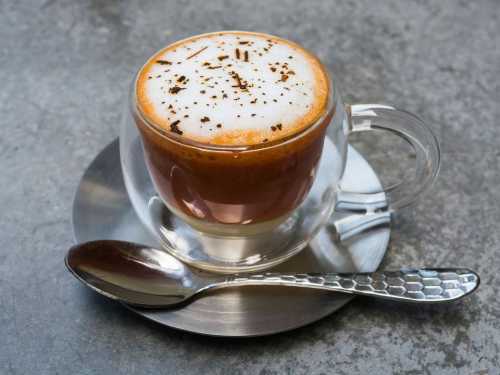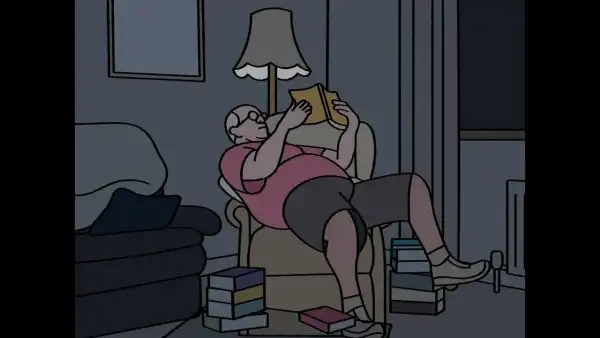
Save this storySave this storySave this storySave this storyYou are perusing the Goings On bulletin, an advisory of what we are viewing, hearing, and experiencing this week. Subscribe to have it delivered to your inbox.
Ragnar Kjartansson’s latest presentation, “Sunday Without Love” (at Luhring Augustine, until Dec. 20), is comprised of just a single piece—and it is quite subdued, considering the artist’s usual style. The forty-nine-year-old artist from Iceland is renowned for his projects involving collective perseverance: in “Take Me Here by the Dishwasher: Memorial for a Marriage” (2011/14), a screening of his parents acting in a film from 1977 is paired with ten musicians performing live with guitars and reciting a song with words extracted from the movie’s screenplay. Back in 2014, when the artwork was showcased at the New Museum, the performers played consistently (with breaks) for a large part of the eight-week display.
 A still from “Sunday Without Love.”Art work © Ragnar Kjartansson / Courtesy the artist / Luhring Augustine /i8 Gallery; Photograph by Börkur Arnarson
A still from “Sunday Without Love.”Art work © Ragnar Kjartansson / Courtesy the artist / Luhring Augustine /i8 Gallery; Photograph by Börkur Arnarson
“Sunday Without Love” is comparatively stripped down—a solitary-shot, nineteen-minute film recording a scene derived from a three-hour live show on a lawn in Italy, captured last autumn. In the style typical of Kjartansson, the piece represents a cultural fusion: the setup and attire took cues from a mid-20th-century folk picture card he possesses, echoing Georges Seurat’s renowned artwork “A Sunday Afternoon on the Island of La Grande Jatte”; the music comprises a deeply felt modification, done in conjunction with Davíð Þór Jónsson, of a German comical tune originating from the nineties called “Ohne Liebe Leben Lernen” (“Learning to Live Without Love”).
Kjartansson’s talent for blending such different and at times vague aspects into a coherent whole stands as a key element of his virtuosity. He is also an expert with repetition: in this instance, a group of ten individuals (Kjartansson among them) craft a folk-art tableau vivant while repeatedly performing the song’s refrain. Such uniformity restricts emotional release, despite the inviting nature of the pastoral backdrop. These kinds of contradictions fuel his creations, which are, at their peak, equally absurd and insightful (to exemplify, the lines “You must learn to live / live without love / love is not good for you” are sung mournfully). I have to admit that, while viewing the footage, I started pondering whether Kjartansson’s artistic perspective might be approaching parody—but, a day later, I found myself unable to dislodge his melody from my thoughts.

About Town
Off Broadway
Drawing inspiration from a 2022 surge of tweets questioning whether Anne Frank benefited from “white privilege,” the exuberant musical “Slam Frank” reinterprets her biography in a way that promotes inclusivity. Anne is now portrayed as Anita (Olivia Bernábe), a Latinx person who, along with her Black mother (Austen Horne), her gay, neurodivergent father (Rocky Paterra), and her still-Jewish sister (Anya van Hoogstraten), goes into hiding. Co-creator and composer Andrew Fox, in collaboration with book writer Joel Sinensky, capitalize on the “Hamilton” vibe; the performances of Bernábe and Horne in rap form count as among the highlights of the show. A significant part of the work is aimed at poking fun at accepted liberal principles and commonplace depictions, yet a grim development toward the end poses a disconcerting question: Can a space of safety exist without the marginalization of figures perceived as posing potential threats?—Dan Stahl (Asylum NYC; until Dec. 28.)
Classical
Many groups may hesitate when considering the creation of a performance featuring female composers active in the seventeenth century. How extensive would that concert need to be, ten minutes perhaps? However, careful research will unearth a wide array of musical compositions that women produced in that era—a subject worthy of acknowledgment. No ensemble recognizes this better than L’Arpeggiata, the global early-music organization established by the lutenist and theorbist Christina Pluhar. Serving as part of Carnegie Hall’s Baroque Unlimited series, their performance of “Wonder Women” puts the spotlight on compositions by Francesca Caccini, Barbara Strozzi, Antonia Bembo, and several others, placing focus on improvisation. Should a piece by a male make its way in, be certain it has likely been modified by a woman or references one.—Jane Bua (Zankel Hall; Nov. 20.)
Rock Geese.Photograph by Mark Sommerfeld
Geese.Photograph by Mark Sommerfeld
Prospects of attending college nearly became the reason behind the split of the Brooklyn-based rock band Geese. The guitarist Emily Green, the bassist Dominic DiGesu, the drummer Max Bassin, and the front man Cameron Winter came together as high-school students attending Brooklyn Friends and L.R.E.I. in 2016, independently putting out the LP “A Beautiful Memory” in 2018. At the time of graduation, in 2020, they found themselves on the path to dispersing, set to follow their separate acceptance letters, until the demos of the band began to draw attention. Over the course of the following five years, Geese has come to be known as a fresh source of inspiration for post-punk music, changing into an ambitious art-rock experiment across a collection of three albums. “Getting Killed,” the newest record from the band, co-produced in conjunction with the beatmaker and engineer Kenny Beats, is more unusual and intense, surfacing in surges of suffering and outrage.—Sheldon Pearce (Brooklyn Paramount; Nov. 20-21.)
Art
Kader Attia’s film “La Valise Oubliée” (2024) unlocks a plethora of family reminiscences, using photographs and archival pieces unearthed from three suitcases to reveal accounts tied to the background of the Algerian independence campaign. In a series of collages that go along with the film, the topic of cultural remembrance—and its misappropriation—surfaces, in which images depicting West African sculptures are torn apart—as if impacted by the explosive aggression of colonialism—and patched back together with visuals and text taken from European art catalogues. These creations share an inescapable and deliberate resemblance to European artistic conventions influenced by African sculpture (e.g., Picasso and Braque). However, the perspective has been inverted; the entitlement to memory, to cultural heritage, is already fragmented.—Zoë Hopkins (Lehmann Maupin; until Dec. 20.)
Dance Dutch National Ballet performs Ted Brandsen’s “The Chairman Dances.”Photograph by Marc Haegeman
Dutch National Ballet performs Ted Brandsen’s “The Chairman Dances.”Photograph by Marc Haegeman
To mark the Dutch National Ballet’s first substantial visit to New York since the eighties, they will present a curated assortment, featuring pieces from Jiří Kylián, Ted Brandsen—director since 2003—and the South African choreographer Mthuthuzeli November, largely unknown in the United States, in addition to a collection of pieces from the company’s most respected figure, the choreographer Hans van Manen, aged ninety-three. Alexei Ratmansky, a fellow-choreographer, has taken on the function of associate artist there, and his recent “Trio Kagel,” paired with accordion tracks crafted by the Argentinean musician Mauricio Kagel, makes an appearance on one program, alongside Jerome Robbins’s personal Chopin suite “Other Dances,” performed by the deeply expressive Olga Smirnova and Jacopo Tissi, both of whom parted ways with the Bolshoi following the start of the Russian intervention in Ukraine.—Marina Harss (City Center; Nov. 20-22.)
Movies
When the filmmaker Charlie Shackleton couldn’t get authorization to a nonfiction crime novel he had in mind to develop into a documentary, he opted for the next most viable option: he created a movie about the movie he would have put together. The result, “Zodiac Killer Project,” is both an enthralling exploration of a real investigation and an insightful commentary on well-worn conventions typical of nonfiction crime documentaries. The novel involved, penned by Lyndon E. Lafferty, recounts the author’s ambitious attempts at figuring out the infamous situation. Shackleton’s narration detailing the scenes he would have shot merges with intelligent visuals capturing relevant locations and articles, sketching Lafferty’s eccentric account while steering clear of infringing on the book’s copyright. With its cautious pursuit of unachievable ambitions, Shackleton’s theoretical approach, equally rich and reserved, symbolizes a major development within first-person filmmaking.—Richard Brody (Opening Nov. 21.)
Bar Tab
Taran Dugal takes pleasure in a liquid meal consisting of three courses, followed by dinner, around the Lower East Side.
 Illustration by Patricia Bolaños
Illustration by Patricia Bolaños
The lifespan of Manhattan’s unique bars is compressed. Excitement and praise that starts it off often dwindles to a feeling of recognized custom. Double Chicken Please, a resourceful cocktail lounge on the Lower East Side that started up in 2020, defies this pattern—most evenings feature lines that span the block. On one recent evening, a couple of first-timers were positioned by the bar within the Coop, the location’s refined back room, complete with mid-century-modern décor and loud house music. A pink glow covered the chicken-based motifs, a lighthearted accent for the otherwise sophisticated space, which was filled with chattering hipsters. The duo decided on a three-course serving from the cocktail menu, which features a selection of twelve cocktails made to bring to mind famous plates. The Japanese Cold Noodle, their appetizer, had a saccharine and crisp essence, enhanced with enjoyable umami hints; the Cold Pizza, the principal dish, had a somewhat unsettling similarity to its reference, a rich blend of tequila, tomato, and basil. Dessert, however, was the climax: the French Toast, a vodka-based option presented with a hand-made cookie containing chocolate-coffee ganache, was delicate and foamy, with just a dash of tartness that reminded them it was, actually, a mixed drink, not a milkshake. With the liquid course finalized, they proceeded to more conventional food: the sloppy, pleasurable “bolognese grilled cheese” chicken sandwich, and “Le Big Mac,” a pleasure constructed like a burger but comprised of chocolate ice cream, macaron, yuzu, and mochi. Later into the night, a celebratory feeling took over; one table cheered as a formerly particular bartender joined them for a shot and headed back to the bar, exchanging high-fives with colleagues. Another patron finished her French Toast, and, while licking her lips, gave voice to the adage on everyone else’s mind: “Man—we’re so fucking fortunate to reside in New York.”
P.S. Some internet treasures:
- Learning how to handle setbacks
- A touch of the season
- To aid you during the weather
Sourse: newyorker.com






